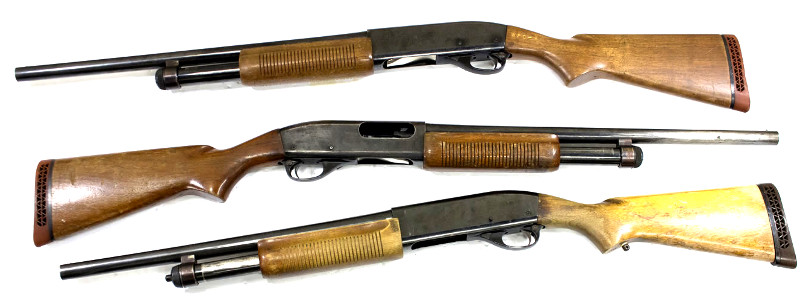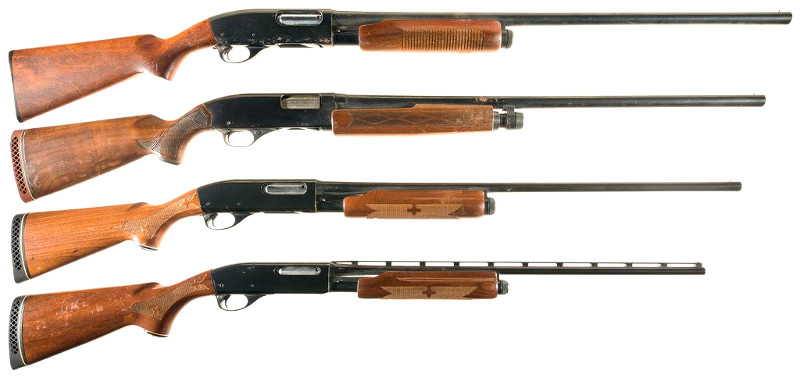Difference between revisions of "Remington 870 Shotgun"
m |
m |
||
| (One intermediate revision by one user not shown) | |||
| Line 2: | Line 2: | ||
[[File:Remington870c.jpg]] | [[File:Remington870c.jpg]] | ||
| + | |||
| + | Remington produced the Model 870 in 1950, which was more modern and reliable in its construction than previous attempts. Introduced in 12, 16, and 20 gauge from the start, as well as in Trap and Skeet grade, the 870 was a commercial success. They reached two million guns by 1973. As of 1983, the 870 held the record for the best-selling shotgun in history, with three million sold and on April 13, 2009, the ten millionth Model 870 was produced. | ||
| + | |||
| + | A 3-inch magnum 12-gauge joined the lineup in 1955, followed by the magnum 20 five years later, and 870s have been offered in a model for nearly every conceivable application. One of the most important introductions occurred in 1987, when the Express model came out. A budget version of the 870, it had a hardwood stock in place of walnut and a lower level of polish inside and out, but in all other ways it was identical to the original. | ||
| + | |||
| + | The original 870 models were offered with fixed chokes. In 1986 Remington introduced the new Remington "Rem Choke" system of screw-in chokes. | ||
| + | |||
| + | == Shell Size == | ||
If your Model 870 serial number ends with "M" you have a 12-gauge Magnum receiver that is capable of shooting 2 3/4-inch and 3-inch shells as long as your barrel is chambered for 3" shells. | If your Model 870 serial number ends with "M" you have a 12-gauge Magnum receiver that is capable of shooting 2 3/4-inch and 3-inch shells as long as your barrel is chambered for 3" shells. | ||
| Line 7: | Line 15: | ||
If your serial number ends with "A", you have a 12-gauge Super Magnum receiver that is capable of shooting 2 3/4-inch, 3-inch and 3 1/2-inch shells with a barrel that is chambered for 3 1/2" shells. | If your serial number ends with "A", you have a 12-gauge Super Magnum receiver that is capable of shooting 2 3/4-inch, 3-inch and 3 1/2-inch shells with a barrel that is chambered for 3 1/2" shells. | ||
| − | If your serial number ends in "N" or "U", you have a 20-gauge Magnum receiver that is capable of shooting 3-inch shells with the correct barrel. | + | If your serial number ends in "N" or "U", you have a 20-gauge Magnum receiver that is capable of shooting 3-inch shells with the correct barrel. |
| + | == Examples == | ||
Remington 870 Wingmaster 12 Gauge Police | Remington 870 Wingmaster 12 Gauge Police | ||
| Line 18: | Line 27: | ||
[[File:Remington870b.jpg]] | [[File:Remington870b.jpg]] | ||
| + | == Lesser Models == | ||
| + | |||
| + | Remington 870s to Avoid: Early 20-gauge 870s were made by putting 20 gauge barrels on 12-gauge receivers and were too heavy for a 20, this was later stopped. All 16-gauge 870s are made on 12-gauge frames so there is no weight advantage to going with the 16, therefore mostly pointless. Sadly in the early 2000s, 870 Express quality control was hit and miss. | ||
| + | This is a short list of problem models and therefore a very insignificant minority of their production as well as some of the issues are really a preference. For example, why buy a 16 gauge if it weighs the same as the 12-gauge? Some might say they want the lesser power shell. You can use light loads on a 12 with less shot to feel like a 16-gauge, yet it might not be the same so if you want a heavy 16-gauge then you would not necessarily consider this a bad model. In 1969 Remington introduced 28 gauge and .410 bore models on a new scaled-down receiver size, and in 1972 a 20 gauge Lightweight ("LW") version was introduced on the same sized receiver, and all of the smaller gauges today are produced on that size receiver. | ||
| + | Production 870s for over 30 years had a design whereby a user could fail to press a shell all the way into the magazine when loading such that the shell latch did not engage the shell, and such actions could tie up the gun. This was caused by the shell which slipped out of the magazine under the bolt in the receiver to bind the action, requiring rough treatment of the action or even disassembly to clear by the uninitiated. The potential issue was resolved with the introduction of the "Flexi Tab" carrier. Guns with this modification can be identified by the "U"-shaped cut-out on the carrier, visible from below the gun. The cut-out, combined with a modified machining on the underside of the slide assembly, allows the action to be opened with a shell on the carrier. | ||
[[Category:Sports and Recreation]] | [[Category:Sports and Recreation]] | ||
[[Category:Firearms]] | [[Category:Firearms]] | ||
[[Category:Tangible Product]] | [[Category:Tangible Product]] | ||
Latest revision as of 11:08, 28 August 2021
The Remington Model 870 is a pump-action shotgun. The 870 features a bottom-loading, side ejecting receiver, tubular magazine under the barrel, dual action bars, internal hammer, and a bolt which locks into an extension in the barrel.
Remington produced the Model 870 in 1950, which was more modern and reliable in its construction than previous attempts. Introduced in 12, 16, and 20 gauge from the start, as well as in Trap and Skeet grade, the 870 was a commercial success. They reached two million guns by 1973. As of 1983, the 870 held the record for the best-selling shotgun in history, with three million sold and on April 13, 2009, the ten millionth Model 870 was produced.
A 3-inch magnum 12-gauge joined the lineup in 1955, followed by the magnum 20 five years later, and 870s have been offered in a model for nearly every conceivable application. One of the most important introductions occurred in 1987, when the Express model came out. A budget version of the 870, it had a hardwood stock in place of walnut and a lower level of polish inside and out, but in all other ways it was identical to the original.
The original 870 models were offered with fixed chokes. In 1986 Remington introduced the new Remington "Rem Choke" system of screw-in chokes.
Shell Size
If your Model 870 serial number ends with "M" you have a 12-gauge Magnum receiver that is capable of shooting 2 3/4-inch and 3-inch shells as long as your barrel is chambered for 3" shells.
If your serial number ends with "A", you have a 12-gauge Super Magnum receiver that is capable of shooting 2 3/4-inch, 3-inch and 3 1/2-inch shells with a barrel that is chambered for 3 1/2" shells.
If your serial number ends in "N" or "U", you have a 20-gauge Magnum receiver that is capable of shooting 3-inch shells with the correct barrel.
Examples
Remington 870 Wingmaster 12 Gauge Police
870 Wingmaster Sporting
Lesser Models
Remington 870s to Avoid: Early 20-gauge 870s were made by putting 20 gauge barrels on 12-gauge receivers and were too heavy for a 20, this was later stopped. All 16-gauge 870s are made on 12-gauge frames so there is no weight advantage to going with the 16, therefore mostly pointless. Sadly in the early 2000s, 870 Express quality control was hit and miss.
This is a short list of problem models and therefore a very insignificant minority of their production as well as some of the issues are really a preference. For example, why buy a 16 gauge if it weighs the same as the 12-gauge? Some might say they want the lesser power shell. You can use light loads on a 12 with less shot to feel like a 16-gauge, yet it might not be the same so if you want a heavy 16-gauge then you would not necessarily consider this a bad model. In 1969 Remington introduced 28 gauge and .410 bore models on a new scaled-down receiver size, and in 1972 a 20 gauge Lightweight ("LW") version was introduced on the same sized receiver, and all of the smaller gauges today are produced on that size receiver.
Production 870s for over 30 years had a design whereby a user could fail to press a shell all the way into the magazine when loading such that the shell latch did not engage the shell, and such actions could tie up the gun. This was caused by the shell which slipped out of the magazine under the bolt in the receiver to bind the action, requiring rough treatment of the action or even disassembly to clear by the uninitiated. The potential issue was resolved with the introduction of the "Flexi Tab" carrier. Guns with this modification can be identified by the "U"-shaped cut-out on the carrier, visible from below the gun. The cut-out, combined with a modified machining on the underside of the slide assembly, allows the action to be opened with a shell on the carrier.


